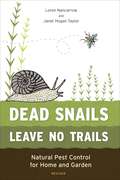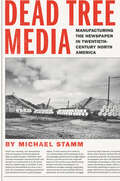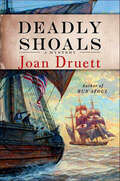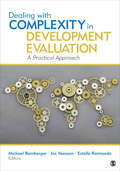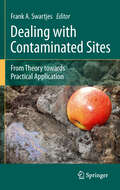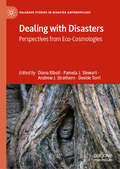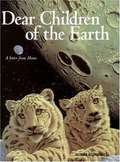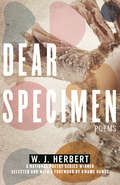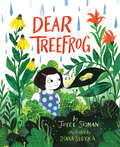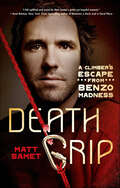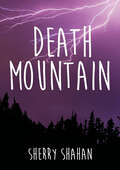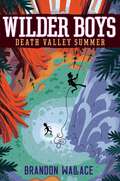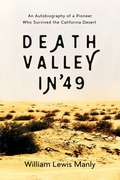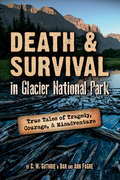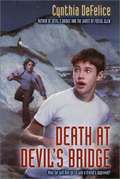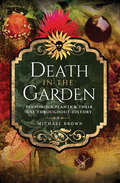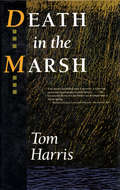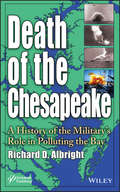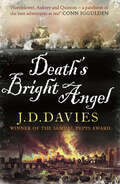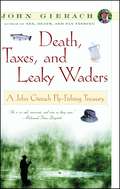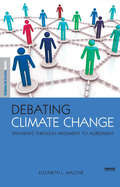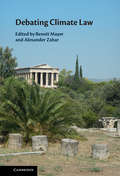- Table View
- List View
Dead Snails Leave No Trails, Revised: Natural Pest Control for Home and Garden
by Loren Nancarrow Janet Hogan TaylorA practical guide to repelling indoor and outdoor pests using organic methods, updated with new information on getting rid of bedbugs and dust mites, plus includes updated online resources. If you've ever had a swarm of fruit flies in your kitchen or a gopher wreaking havoc in your yard, you may have wondered what a conscientious gardener or homeowner can do short of heavy-duty chemical warfare. Dead Snails Leave No Trails is a comprehensive guide to repelling both indoor and outdoor pests using organic methods--it's the perfect DIY solution to eliminate unwelcome visitors in your home and garden while keeping yourself,your family, and the environment safe from harmful chemicals.With a few easy-to-find items, you'll learn how to: * Make your own all-purpose pest repellents with simple ingredients like chile peppers and vinegar * Use companion planting to attract beneficial insects and animals or repel harmful ones * Keep four-legged intruders--including squirrels, deer, rabbits, and skunks--away from your prized vegetables and flowers * Safely eliminate ants, roaches, and rodents from your house or apartment * Protect your pets from critters like ticks and fleas This revised edition contains newly updated information on today's pest epidemics, like bedbugs, as well as new online resources for finding beneficial organisms that act as predators for specific pests. Full of tips, tricks, and straightforward instructions, Dead Snails Leave No Trails is the most user-friendly guide to indoor and outdoor natural pest solutions.
Dead Tree Media: Manufacturing the Newspaper in Twentieth-Century North America (Hagley Library Studies in Business, Technology, and Politics)
by Michael StammA deep and timely account of how American newspapers were produced and distributed on paper.Winner of the Best Book in Canadian Business History by the Canadian Business History AssociationPopular assessments of printed newspapers have become so grim that some have taken to calling them "dead tree media" as a way of invoking the medium’s imminent demise. There is a literal truth hidden in this dismissive expression: printed newspapers really are material goods made from trees. And, throughout the twentieth century, the overwhelming majority of trees cut down in the service of printing newspapers in the United States came from Canada. In Dead Tree Media, Michael Stamm reveals the international history of the commodity chains connecting Canadian trees and US readers. Drawing on newly available corporate documents and research in archives across North America, Stamm offers a sophisticated rethinking of the material history of the printed newspaper. Tracing its industrial production from the forest to the newsstand, he provides an account of the obscure and often hidden labor involved in this manufacturing process by showing how it was driven by not only publishers and journalists but also lumberjacks, paper mill workers, policymakers, chemists, and urban and regional planners. Stamm describes the 1911 shift in tariff policy that gave US publishers duty-free access to Canadian newsprint, providing a tremendous boost to Canadian paper manufacturers and a significant subsidy to American newspaper publishers. He also explains how Canada attracted massive American foreign investment in paper mills around the same time that US publishers were able to gain greater access to Canada’s vast spruce forests. Focusing particularly on the Chicago Tribune, Stamm provides a new history of the rise and fall of both the mass circulation printed newspaper and the particular kind of corporation in the newspaper business that had shaped many aspects of the cultural, political, and even physical landscape of North America. For those seeking to understand the travails of the contemporary newspaper business, Dead Tree Media is essential reading.
Deadly Shoals: A Mystery (Wiki Coffin Mysteries)
by Joan DruettWiki Coffin plays many parts on the U.S. Exploring Expedition---sailor, linguist, navigator, and, as half-Maori, cultural go-between. But then the brig Swallow reaches the coast of Patagonia, an area infamous for its rough gauchos and revolutionary spirit, and he must take on his other role, that of agent of U.S. law and order. A New England whaler shows up, desperate to find the devious trader who has cheated him of a thousand dollars and a schooner. Wiki is assigned to find the missing ship, only to follow a trail of clues to a dead body, half-buried in a hill of salt, its skull picked clean by vultures. The adventure unravels in the impoverished village of El Carmen de Patagones, where the threat of French invasion is imminent, and business is at a standstill under the orders of General de Rosas, the tyrant of Buenos Aires. Wiki must risk both life and reputation in pursuit of a vicious and determined killer who has set his sights on another target: the U.S. Exploring Expedition itself.
Dealing With Complexity in Development Evaluation: A Practical Approach
by Michael Bamberger Jos Vaessen Estelle RaimondoRecognizing that complexity calls for innovative, conceptual, and methodological solutions, this unique book offers practical guidance to policymakers, managers, and evaluation practitioners on how to design and implement complexity-responsive evaluations that can be undertaken in the real world of time, budget, data, and political constraints. Introductory chapters present comprehensive, non-technical overviews of the most common evaluation tools and methodologies, and additional content addresses more cutting-edge material. The book also includes six case study chapters to illustrate examples of various evaluation contexts from around the world.
Dealing With Complexity in Development Evaluation: A Practical Approach
by Michael Bamberger Jos Vaessen Estelle RaimondoRecognizing that complexity calls for innovative, conceptual, and methodological solutions, this unique book offers practical guidance to policymakers, managers, and evaluation practitioners on how to design and implement complexity-responsive evaluations that can be undertaken in the real world of time, budget, data, and political constraints. Introductory chapters present comprehensive, non-technical overviews of the most common evaluation tools and methodologies, and additional content addresses more cutting-edge material. The book also includes six case study chapters to illustrate examples of various evaluation contexts from around the world.
Dealing with Contaminated Sites
by Frank A. SwartjesThis standard work on contaminated site management covers the whole chain of steps involved in dealing with contaminated sites, from site investigation to remediation. An important focus throughout the book is on Risk Assessment. In addition, the book includes chapters on characterisation of natural and urban soils, bioavailability, natural attenuation, policy and stakeholder viewpoints and Brownfields. Typically, the book includes in-depth theories on soil contamination, along with offering possibilities for practical applications. More than sixty of the world's top experts from Europe, the USA, Australia and Canada have contributed to this book. The twenty-five chapters in this book offer relevant information for experienced scientists, students, consultants and regulators, as well as for 'new players' in contaminated site management
Dealing with Disasters: Perspectives from Eco-Cosmologies (Palgrave Studies in Disaster Anthropology)
by Pamela J. Stewart Andrew J. Strathern Davide Torri Diana RiboliProviding a fresh look at some of the pressing issues of our world today, this collection focuses on experiential and ritualized coping practices in response to a multitude of environmental challenges—cyclones, volcanic eruptions, tsunamis, earthquakes, warfare and displacements of peoples and environmental resource exploitation. Eco-cosmological practices conducted by skilled healing practitioners utilize knowledge embedded in the cosmological grounding of place and experiences of place and the landscapes in which such experience is encapsulated. A range of geographic case studies are presented in this volume, exploring Asia, Europe, the Pacific, and South America. With special reference throughout to ritual as a mode of seeking the stabilization, renewal, and continuity of life processes, this volume will be of particular interest to readers working in shamanic and healing practices, environmental concerns surrounding sustainability and conservation, ethnomedical systems, and religious and ritual studies.
Dear Children of the Earth
by Schim SchimmelThis illustrated letter from Mother Earth is designed to remind children of all ages of the responsibility we all have to protect the world in which we live. It poses then answers to the question: what can we do to help save our home?
Dear Papa: Letters Between John Muir and His Daughter Wanda
by Jean Hanna Clark Shirley SargentLetters between the famous naturalist and his daughter.
Dear Specimen: Poems
by W.J. HerbertA National Poetry Series winner, selected and with a foreword by Kwame Dawes.A 5-part series of interwoven poems from a dying parent to her daughter, examining the human capacity for grief, culpability, and love, asking: do we as a species deserve to survive? Dear Specimen opens with both its speaker and her planet in peril. In &“Speak to Me,&” she puzzles over a millipede, as if the blue rune of its body could help her understand her impending death and the crisis her species has created. Throughout the collection, poems addressed to specimens echo the speaker&’s concern and amplify her wonderment. A catalog of our climate transgressions, Dear Specimen&’s final poem foretells a future in which climate refugees overrun one of our planet&’s last habitable places. The collection&’s lifeblood is a series of poems in which the speaker and her daughter express their concern for, and devotion to, one another. The daughter&’s questions mirror the ones her mother asks of specimens: what are we meant to do with so much hazard and wonder? When the speaker hints at the climate crisis in a bedtime story she tells her grandson, we, too, feel the peril he may face. Juxtaposing a profound sense of intimacy with the vastness of geological time, the collection offers a climate-conscious critique of the human species—our search for meaning and intimacy, our capacity for greed and destruction. Dear Specimen is an extended love letter and dire warning, not only to the daughter its speaker leaves behind but to all of us.
Dear Treefrog
by Joyce SidmanCapturing the joy of finding a kindred spirit, this stunning picture book by Newbery Honor–winning poet Joyce Sidman tells the story of a lonely girl moving into a new home and the little treefrog that helps her connect to the beautiful world around her. Perfect for fans of A Butterfly Is Patient and They Saw a Cat.I See You suddenly among the tangled green a tiny dollop of frog where before there was only leaf . . . Are you new here too? When a shy girl moves to a strange new home, she discovers a treefrog perched in a secret spot nearby and learns that sometimes, all it takes to connect with the people and the world around us is a little patience, a curious mind, and a willingness to see the world through a different perspective than your own. With beautiful gouache illustrations by Diana Sudyka and magical, perceptive poems from Newbery Honor–winning author Joyce Sidman, the lives of one tree frog and the girl who discovers it converge, bringing solace, courage, and joy in finding a kindred spirit.
Death Grip: A Climber's Escape from Benzo Madness
by Matt SametDeath Grip chronicles a top climber's near-fatal struggle with anxiety and depression, and his nightmarish journey through the dangerous world of prescription drugs. Matt Samet lived to climb, and craved the challenge, risk, and exhilaration of conquering sheer rock faces around the United States and internationally. But Samet's depression, compounded by the extreme diet and fitness practices of climbers, led him to seek professional help. He entered the murky, inescapable world of psychiatric medicine, where he developed a dangerous addiction to prescribed medications—primarily "benzos," or benzodiazepines—that landed him in institutions and nearly killed him.With dramatic storytelling, persuasive research data, and searing honesty, Matt Samet reveals the hidden epidemic of benzo addiction, which some have suggested can be harder to quit than heroin. Millions of adults and teenagers are prescribed these drugs, but few understand how addictive they are—and how dangerous long-term usage can be, even when prescribed by doctors.After a difficult struggle with addiction, Samet slowly makes his way to a life in recovery through perseverance and a deep love of rock climbing. Conveying both the exhilaration of climbing in the wilderness and the utter madness of addiction, Death Grip is a powerful and revelatory memoir.
Death Mountain
by Sherry ShahanAn afternoon hike in the Sierra Mountains turns into a struggle for survival when two teenage girls become hopelessly lost in an electrical storm and must rely on their own wits and strength to endure.Almost a year ago, Erin's mother Lannie suddenly left home without any explanation. Now Lannie wants to see her, but Erin feels miserable and unsure about seeing her mother again.After "losing" her bus ticket on the way to visit her mother, Erin hitches a ride with Mae and her older brother, Levi. Along the way, she joins the two siblings for a hike along the eastern slope of the Sierra Nevada Mountains. When a deadly storm suddenly descends upon the mountain and lightning strikes, everyone on the crowded trails scrambles for safety and Erin and Mae become separated from the others. As the days pass, the two stranded girls must rely on their own determination and skills, as well as each other, to survive.Author Sherry Shahan's dramatic story displays perceptive insights into the conflicted hearts and minds of teenagers, as well as a thorough understanding of the natural world and technical details of mountaineering. An afterword includes details of Shahan's own harrowing alpine adventure that inspired the novel.
Death Valley Summer (Wilder Boys)
by Brandon WallaceTwo brothers try to lead lost campers to safety in the fourth adventure of the Wilder Boys series.The boys help out at a wilderness camp near Sequoia National Park, a day&’s drive south of the Sierras. The camp&’s main draw is a multi-day trek traversing woodlands, mountains, and desert during a team-based orientation competition that will take them to the edge of Death Valley. When Jake and Taylor&’s team counselor is badly hurt in a flash flood, they must galvanize the lost campers to find shelter, aid the injured counselor, and supplement their low supplies with what can be found around them. At first, stumbling across a ghost town seems like a lucky break from the scorching heat of summer, but the town is already occupied by counterfeiters who are none too pleased about their operation being discovered. The boys must use all their resourcefulness and knowledge of the outdoors to protect their teammates from the criminals and the elements.
Death Valley in '49: An Autobiography of a Pioneer Who Survived the California Desert
by William ManlyA survivor’s true account of death, despair, and heroism in Death Valley in the heat of the California Gold Rush. At the height of the California gold rush in 1849, a wagon train of men, women, children, and their animals stumbled into a 130-mile-long valley in the Mojave Desert while they were looking for a shortcut to the California coast. What ensued was an ordeal that divided the camp into remnants and struck them with hunger, thirst, and a terrible sense of being lost beyond hope—until a twenty-nine-year-old hero volunteered to cross the desert to get help. This young hero, William Lewis Manly, was one of the survivors of the tragedy, and he lived to tell the tale forty-five years later in this gripping autobiography, first published in 1894. In a time of unmarked frontiers and wilderness, Manly lived the true life of a pioneer. After being hit by gold rush fever Manly joined the fateful wagon train that would get swallowed up by the barren, arid, hostile valley with its dry and waterless terrain, unearthly surface of white salts, and overwhelming heat. Assaulted and devastated by the elements, members of the camp killed their emaciated oxen for food, ran out of water, split up, and lost and buried their own kind who perished. When Manly’s remaining band of ten came across a rare water hole, he and a companion, John Rogers, left the rest by the water and crossed the treacherous Panamint Mountains and Mojave Desert by themselves in search for rescue. In a true act of heroism against all odds, the two finally returned twenty-five days later with help, rescuing their compatriots, including four children, even when it seemed all hope was lost. Told at the end of the nineteenth century, Manly’s compelling and stirring account brings alive to modern-day readers the unimaginable hardships of America’s brave pioneers, and a chapter in Californian history that should not be forgotten.
Death and Survival in Glacier National Park: True Tales of Tragedy, Courage, and Misadventure
by C. W. Guthrie Ann Fagre Dan Farge<p>Sheer cliffs, avalanches, turbulent rivers, cold lakes, severe weather, grizzly bears - these are just a few of the ways you can die while visiting Glacier National Park. <p>Since 1910 when the park was established, 296 people have perished within Glacier's boundaries, and many more somehow survived close calls with death. Death and Survival in Glacier National Park recounts their true tales, as well as stories of the brave and often heroic search-and-rescue professionals who put their lives on the line so that others might live. <p>Written by local Glacier National Park experts. Jam-packed with gripping stories of courage and survival against all odds. Featuring the most complete chronology of all 296 deaths in Glacier National Park, including names, ages, locations, and causes.</p>
Death at Devil's Bridge
by Cynthia DefeliceThirteen-year-old Ben Daggett is looking forward to his summer job as first mate on a charter fishing boat on Martha's Vineyard. Then, on his first day out, he spots a strange object in the water -- a red Porsche. The driver is missing. Donny, an older teenager, knows something, but he's not telling. Donny has his own car, and Ben would give anything to hang out with him. But Donny's involved in something shady, and Ben finds out that the price of friendship may be more than he can afford to pay.
Death in the Garden: Poisonous Plants & Their Use Throughout History
by Michael Brown&“Readers who enjoy plants and offbeat tales will find Brown&’s book a happy mix&” (Publishers Weekly). Mankind has always had a morbid fascination with poisonous plants. Over the centuries, poisonous plants have been used to remove garden pests—as well as unwanted rivals and deceitful partners. They have also been used for their medicinal qualities, as rather dangerous cosmetics, and even to help seduce a lover when perceived as an aphrodisiac. Some of these and other uses originate in a medieval book that has not yet been translated into English. This book delves into the history of these plants, covering such topics as: How shamans and priests used these plants for their magical attributes, as a means to foretell the future or to commune with the godsHow a pot of basil helped to conceal a savage murderThe truth about the mysterious mandrakeA conundrum written by Jane Austen to entertain her family—the answer to which is one of the plants in this book These stories and many more will enlighten you on these treacherous and peculiar plants, their defensive and deadly traits, the facts behind them, and the folklore that has grown around them.
Death in the Marsh
by Tom HarrisSelenium, essential in microscopic doses, can be deadly in larger amounts. Death in the Marsh explains how federal irrigation projects have altered selenium's circulation in the environment, allowing it to accumulate in marshes, killing ecosystems and wildlife, and causing deformities in some animals.
Death of the Chesapeake: A History of the Military's Role in Polluting the Bay
by Richard AlbrightIn essence this book deals with an area that contributes significantly to the pollution and degradation of Chesapeake Bay, but has been completely overlooked in many of the efforts to restore the Bay, specifically, the federal military pollution sources. The book also recognizes for the first time, that efforts to restore the Bay have failed because of violation of a fundamental precept of environmental cleanup; that is, to sample the site and see what is there. The Bay itself has never been sampled. Thus this book presents a view of the environmental condition of Chesapeake Bay that is totally unique. It covers a part of the history of the Bay that is not widely known, including how the Bay was formed. It presents a mixture of science, military history, and novel solutions to the Bay's degradation. In so doing, the author examines the military use of the Bay and reveals the extent of munitions dumpsites containing nitrogen and phosphorus as well as chemical warfare material, and how this is effecting the environment. The book concludes with the author's own clean-up plan that, if implemented, would go a long way to restoring health to Bay. The book is supplemented with many photographs and maps.
Death's Bright Angel (The Matthew Quinton Journals)
by J. D. DaviesPart of an &“excellent series,&” this seafaring adventure features a Royal Navy captain as he battles terrorism in seventeenth-century England (Publishers Weekly). London is burning, but who set the fire? In the weeks leading up to the Great Fire of 1666, Matthew Quinton, master of the H. M. S. Sceptre, is sent into the heart of London, seething with foreign plots and political paranoia, on a dangerous mission: to keep a terrorist ring from destroying the capital. Quinton is the only man that can stop these men, who want to open the country to invasion by destabilizing the English people and fueling rebellion. But unrest may not be the only thing these men will fuel . . . The heat is rising. With fast-paced action and fantastic historical detail, Death&’s Bright Angel is the seventh thrilling book in the Matthew Quinton series of nautical sagas. Praise for the writing of J. D. Davies: &“Hornblower, Aubrey and Quinton—a pantheon of the best adventures at sea!&” —Conn Iggulden, #1 New York Times–bestselling author of The Conqueror and War of the Roses series &“A hero worth rooting for.&” —Publishers Weekly &“Utterly impossible to put down . . . Finely-shaded characters, excellent plotting, gut-clenching action and immaculate attention to period detail . . . Superb.&” —Angus Donald, author of The Outlaw Chronicles series &“Destined to be a classic of nautical adventure series.&” —Eric Jay Dolin, author of Leviathan and Fur, Fortune, and Empire &“A naval adventure that goes well beyond the usual outlines of the genre to paint a lively portrait of England in the 1600s.&” —Kirkus Reviews
Death, Taxes, and Leaky Waders
by John GierachDeath, Taxes, and Leaky Waders collects forty of John Gierach's finest essays on fishing from six of his books. Like all his writing, these essays are seasoned by a keen sense of observation and a deep knowledge and love of fishing lore, leavened by a wonderfully wry sense of humor. This is the first anthology of Gierach's work, a collection that is sure to delight both die-hard fans and new readers alike.
Death-Facing Ecology in Contemporary British and North American Environmental Crisis Fiction: Ecological Death-facing in Contemporary British and North American Fiction (Routledge Studies in Contemporary Literature)
by Louise SquireRecent years have seen a burgeoning of novels that respond to the environmental issues we currently face. Among these, Louise Squire defines environmental crisis fiction as concerned with a range of environmental issues and with the human subject as a catalyst for these issues. She argues that this fiction is characterized by a thematic use of "death," through which it explores a "crisis" of both environment and self. Squire refers to this emergent thematic device as "death-facing ecology". This device enables this fiction to engage with a range of theoretical ideas and with popular notions of death and the human condition as cultural phenomena of the modern West. In doing so, this fiction invites its readers to consider how humanity might begin to respond to the crisis.
Debating Climate Change: Pathways through Argument to Agreement (The\earthscan Science In Society Ser.)
by Elizabeth L MaloneAs greenhouse gas emissions continue unabated and contentious voices fill the air, the question gains urgency: How can people with widely varying viewpoints agree to address climate change? Each participant in the debate seems to have a different agenda, from protecting economic growth in developing countries to protecting the energy industry in industrialized countries, from those aghast at the damage done to the Earth to optimists who think we just need to adjust our technological approach. Debating Climate Change sorts through the tangle of arguments surrounding climate change to find paths to unexpected sites of agreement. Using an innovative sociological approach - combined discourse and social network analyses - Elizabeth L. Malone analyzes 100 documents representing a range of players in this high-stakes debate. Through this she shows how even the most implacable adversaries can find common ground - and how this common ground can be used to build agreement. Written in a clear, accessible style, this original research and insightful use of communication analysis will help advance understanding and negotiation on climate change throughout the pivotal times to come. Published with Science in Society
Debating Climate Law
by Alexander Zahar Benoit MayerWhat role could or should the law play in dealing with the climate emergency? In this innovative volume, leading scholars explore fundamental debates at the frontier of climate change law scholarship. They address the key areas of scholarly disagreement about what climate change law is, the legal rules it consists of, and how these rules could be implemented in the real world. The first eleven topics are debated by teams of scholars expressing diametrically opposite points of view on each topic, in traditional debating style; the last seven chapters are presented as an individual author's own reflection on a topic that cannot readily be reduced to a binary debate. Each chapter is written in an accessible and thought-provoking way, emphasizing clear lines of argumentation. The debating-style format is designed to stimulate students to think critically and logically about the law and to fire up debate in and out of class.
